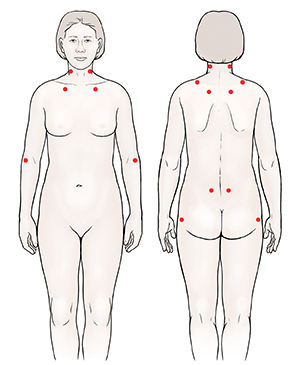Understanding Fibromyalgia
Understanding Fibromyalgia

What are the symptoms of fibromyalgia?
In most cases, you will have tender points on your body. These points are very sore, especially when touched. Finding several of these points helps your healthcare provider diagnose fibromyalgia.
Along with the tender points, you may have some or all of the following symptoms:
-
Constant tiredness (fatigue), even after a full night’s sleep (nonrestorative sleep)
-
A burning or throbbing pain in many parts of the body (this pain may vary during the day)
-
Stiffness or aching all over your body
-
Numbness or tingling in your arms and legs
-
Trouble sleeping
-
Bowel problems (bloating, diarrhea, constipation)
-
Headaches
-
Depression
How is fibromyalgia diagnosed?
There is no lab test to diagnose fibromyalgia. Instead, your healthcare provider will take your health history and examine your joints and muscles. Certain criteria are used when diagnosing fibromyalgia. Symptoms need to be present for at least 3 months. Tests may be done to rule out other conditions with similar symptoms. Then you and your provider can design a plan to help you manage your symptoms.
How is fibromyalgia treated?
Several medicines are approved to treat fibromyalgia. Two were originally made to treat depression. They are duloxetine, and milnacipran. A third, called pregaballin, was developed to treat nerve pain. Certain medicines used to treat depression have been helpful with fibromyalgia. Other medicines include pain relievers such as acetaminophen or stronger opioids. These may be prescribed short term.
Nonsteroidal anti-inflammatory drugs (NSAIDs) are used to relieve pain. These include ibuprofen and naproxen.
Getting enough sleep, regular exercise, and eating a healthy diet can help manage symptoms. A form of talk therapy called cognitive behavioral therapy can be helpful for fibromyalgia. Some people find alternative treatments such as massage, chiropractic treatments, biofeedback, or acupuncture also help with symptoms.
Updated:
March 16, 2019
Sources:
Clinical manifestations and diagnosis of fibromyalgia in adults. UpToDate., Initial treatment of fibromyalgia in adults. UpToDate., Nonpharmacologic Treatment for Fibromyalgia: Patient. Hassett Afton L. Rheum Dis Clin North Am. 2009;35(2):393–407.
Reviewed By:
Freeborn, Donna, PhD, CNM, FNP,Hanrahan, John, MD